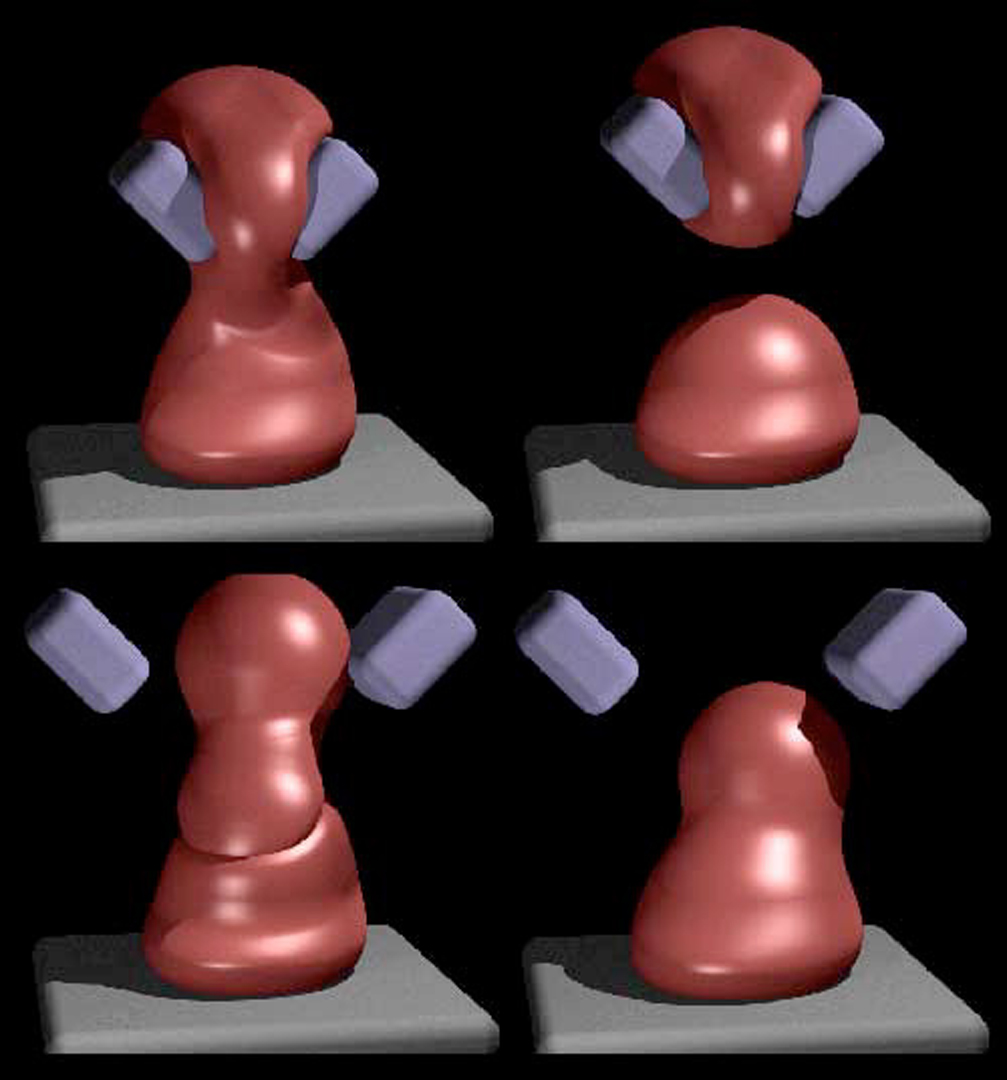“Animating soft substances with implicit surfaces” by Desbrun and Gascuel
Conference:
Type(s):
Title:
- Animating soft substances with implicit surfaces
Presenter(s)/Author(s):
Abstract:
This paper presents a hybrid model for animation of soft inelastic substance which undergo topological changes, e.g. separation and fusion and which fit with the objects they are in contact with. The model uses a particle system coated with a smooth iso-surface that is used for performing collision detection, precise contact modeling and integration of response forces. The animation technique solves three problems inherent in implicit modeling. Firstly, local volume controllers are defined to insure constant volume deformation, even during highly inelastic processes such as splitting or fusion. Secondly, we avoid unwanted distance blending between disconnected pieces of the same substance. Finally, we simulate both collisions and progressive merging under compression between implicit surfaces that do not blend together. Parameter tuning is facilitated by the layered model and animation is generated at interactive rates.
References:
1. Jules Bloomenthal and Brian Wyvill. Interactive techniques for implicit modeling. Computer Graphics, 24(2):109-116, March 1990.
2. Mathieu Desbrun and Marie-Paule Gascuel. Highly deformable material for animation and collision processing. In 5th Eurographics Workshop on Animation and Simulation, Oslo, Norway, September 1994.
3. Mathieu Desbrun, Nicolas Tsingos, and Marie-Paule Gascuel. Adaptive sampling of implicit surfaces for interactive modeling and animation. In First International Workshop on Implicit Surfaces, Grenoble, France, April 1995.
4. Marie-Paule Gascuel. An implicit formulation for precise contact modeling between flexible solids. Computer Graphics, pages 313- 320, August 1993. Proceedings of SIGGRAPH’93 (Anaheim, CA).
5. Annie Luciani, St6phane Jimenez, Olivier Raoult, Claude Cadoz, and Jean-Loup Florens. An unified view of multitude behaviour, flexibility, plasticity, and fractures: balls, bubbles and agglomerates. InlFIP WG 5.10 Working Conference, Tokyo, Japan, April 1991.
6. Agata Opalach and Steve Maddock. Implicit surfaces: Appearance, blending and consistency. In Fourth Eurographics Workshop on Animation and Simulation, Barcelona, Spain, September 1993.
7. John Platt and Alan Bart. Constraint methods for flexible models. Computer Graphics, 22(4):279-288, August 1988. Proceedings of SIGGRAPH’88 (Atlanta, Georgia).
8. Ari Rappoport, Alla Sheffer, Daniel Youlus, and Michel Bercovier. Volume-preserving free-form deformations. In ACM Solid Modeling’95, Salt Lake City, Utah, May 1995.
9. Jean-Paul Smets-Solanes. Surfacic textures for animated implicit surfaces: the 2d case. In Fourth Eurographics Workshop on Animation and Simulation, Barcelona, Spain, September 1993.
10. Demetri Terzopoulos and Kurt Fleischer. Modeling inelastic deformations: Viscoelasticity, plasticity, fracture. Computer Graphics, 22(4):269-278, August 1988. Proceedings of SIGGRAPH’88 (Atlanta, Georgia).
11. Demetri Terzopoulos, John Platt, and Kurt Fleisher. Heating and melting deformable models (from goop to glop). In Graphics Interface’89, pages 219-226, London, Ontario, June 1989.
12. David Tonnesen. Modeling liquids and solids using thermal particles. In Graphics Interface’91, pages 255-262, Calgary, AL, June 1991.
13. Brian Wyvill, Craig McPheeters, and Geoff Wyvill. Animating soft objects. The Visual Computer, 2(4):235-242, August 1986.
14. Brian Wyvill and Geoff Wyvill. Field functions for implicit surfaces. The Visual Computer, 5:75-82, December 1989.




